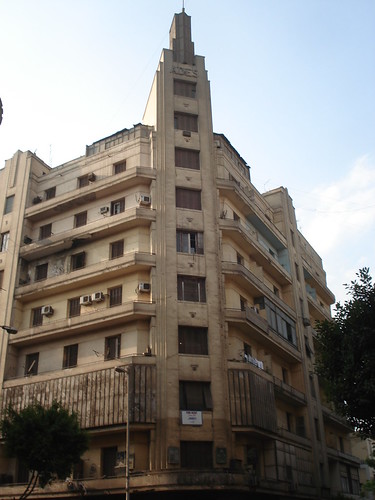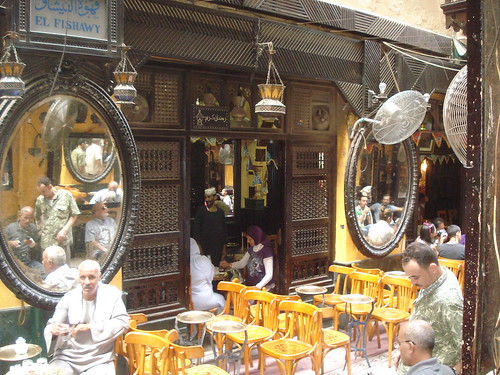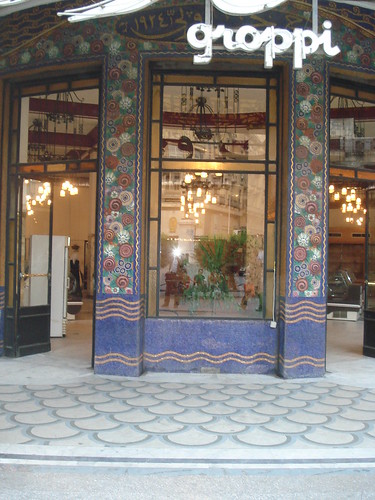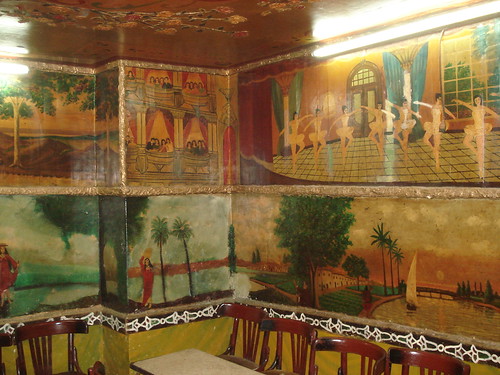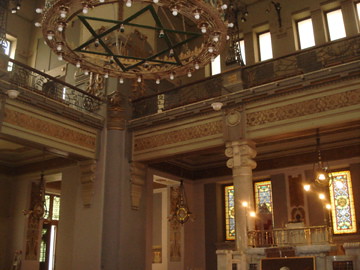I need to start with a confession. I absolutely LOVE Tel Aviv. I LOVE it. I love almost everything about it. I love the crowds, I love the noise, I love the cafes, I love the architecture, I love the history, I love the modernity and most of all, I love the people.
Israelis are great story tellers and I like stories. People here tell you things you would never get told in London. For example, my taxi driver on the way from Ben Gurion airport to my hotel. Let's call him Dudi in case anyone he knows is reading.
He wasn't always a taxi driver. He once owned a successful cafe in the the Dizengoff Centre in Tel Aviv. It was very successful until the worst days of the first intifada when the customers stopped coming, somewhat reasonably as shopping centres were prime targets for suicide bombings day after day. Dudi is entrepreneurial. Before the cafe he had a bar in Netanya for five years. He told me he spent most of that time drunk or in a smoke induced haze. He still likes to drink a little and smoke a little, and overdid it a friend's party at Purim. This was some party since a famous film and TV actress turned up with a surprise present for his friend - a massive reefer - do people still use that word? I couldn't possibly name her but she's a bit of a favourite of mine.
Now you might think Dudi is a bit of a waster, but actually he's not. He told me he is searching for something, that he knows something is missing. He is looking for whatever this thing is through study of Kabbalah. He studies as part of a group and says he feels calmer since he joined. Unfortunately at the Purim party Dudi got too friendly with a lady from his group and now worries he is the subject of gossip amongst his fellow students. It is, he says, "a balagan". Balagan is not a Hebrew word, its probably Arabic and it means a big mess. I like this word. It sounds like what it means. Poor Dudi. Another group perhaps? (Update - balagan is a Russian word, meaning "brothel" - thanks Osnat - no news of Dudi though!)
My hotel is the fabulous Center Hotel on Zamenhof. I have been staying here for several years. I love it. Its a great central location, the staff are very friendly and its been renovated since I was last here. Its in a great Bauhaus building on Kikar Dizengoff (Dizengoff Circus to you). Meir Dizengoff was the first Mayor of Tel Aviv and had a major role in developing the city. Zamenhof invented Esperanto.
I said I love the cafes and I do. My favourite has always been the Dizengoff branch of Cafe Idelson. Nice, light and modern on the ground floor of a two story building on Dizengoff, it has the best cakes in Tel Aviv - in my expert opinion. I nearly always have the pistachio mousse with black cherries together with a very strong coffee. Alternatively, I have been known to be tempted by the passion fruit cheesecake. Staff are friendly and helpful and are usually able to spot people like me who would take the rest of their lives to manage the Hebrew version of the menu.
Another little gem is Cafe Mersand on the junction of Frishman and Ben Yehuda streets. You can almost smell the sea from the pavement tables - its a three minute walk away. Cafe Mersand is a little run down and attracts a young(ish) Bohemian Tel Aviv crowd, but it also has an interesting story attached to it. For many years, a group of Yekkes ladies (that's middle class German speaking Jews who mostly came here in the 1920's and 1930's, in case you don't know) have gathered here on Friday mornings to drink coffee, eat strudel and talk about their children, their grand children and perhaps also about darker times in the past.
They are very neat ladies, with proper attire, jackets (yekkes!), careful hair and make-up and with the type of manners that you don't see anywhere else these days. They speak German with each other. It is not unusual to hear German spoken here, but mainly by tourists. For some reason Germans like to come here, perhaps they have heard about the ladies. But a few years ago I noticed that when German tourists came to the Mersand on the Friday morning and looked in the direction of the ladies, they switched to Hebrew. There are fewer ladies each year, and as they leave us a little piece of Tel Aviv leaves with them.
The Yekkes helped create a vibrant cafe society in Tel Aviv (and elsewhere in Israel) and it would not have been unusual to find the likes of actress Hanna Rovina, poets Shlonsky and Bialik, artists Rubin and Gutman drinking, debating, planning new projects and dreaming together in the years before the second world war. It occurred to me on this visit that cafes are again becoming creative places, but in a different way. Many Tel Aviv cafes offer free wi-fi and you can see Tel Avivian coffee drinkers bashing away on their laptops just about everywhere. Doubtless some of this is "business" but I am sure there are also poets, novelists and playwrights amongst them...
I like to find new cafes to visit and followed a friend's recommendation to try Cafe Gidi also on Frishman. Its a small cafe with a tiny front terrace facing onto the main road but also with a little patio garden at the back with several tables, a number of interesting lamps, shady trees, a pond and some garden gnomes. Not surprisingly, Cafe Gidi also has a story. Gidi is the son of one Aba Dill, an Afghan Jew who came to Eretz Israel in 1935 aged 16. Aba learned how to make lampshades and soon established a workshop in the Florentin district of the city. Son Gidi joined him and eventually took over the business, opening "The House of Lamps" store in Ramat Gan in 1976. After many years, and struggling to compete with mass produced imports, Gidi closed the business and reinvested instead in a "house of coffee". The lampshades you can see here are from the old days.
Something else I love about Tel Aviv is the easy access to really high quality live music. In just a few days here I have been spoiled for choice. On Wednesday night I enjoyed an Ethiopian influenced jazz concert at the Hasimta Theatre in Jaffa. The theatre is primarily a venue for drama but has a weekly jazz night. It is an atmospheric space with the audience seated at little tables in a dark, cave-like room built deep into the walls of old Jaffa. The quintet - Shabate - demonstrate the diversity of Israeli society, the sax playing vocalist is Ethiopian, at least two of the group are Mizrachi and three are "religious". Their set was interesting. They began with a very cool, almost Brazilian sounding jazz number before delving into more African sounds and even a jazz version of a traditional Pesach song, all with sudden changes in rhythm and direction.
Last night I went to Levontin 7, another small venue, this time in a basement in the Florentin district of the city. I have been here before - I was lucky enough to see Maurice el Medioni and Omri Mor perform "Oriental" piano three years ago, and still get goose pimples thinking about it. This time it was another pianist - Yonatan Avichai. Yonatan has played with most of the top Israeli jazz groups, but this was a solo performance. He played continuously for over an hour, mixing free form jazz, with modern classical music and managing to knit in some jazz standards including "I've got it bad and that ain't good" and a pretty wild version of "Alexander's ragtime band". Levontin 7 is a very intimate venue and the audience is very close to the artist. I could hear Yonatan making those strange grunting noises pianists often make and see very clearly his changing facial expressions. Playing a musical instrument is an intensely physical exercise for some musicians. It was a great performance and a somewhat emotional and very tired looking Yonatan treated us to a borderline camp version of "La vie en rose" as an encore. And of course, we loved it!
Last night I went to Levontin 7, another small venue, this time in a basement in the Florentin district of the city. I have been here before - I was lucky enough to see Maurice el Medioni and Omri Mor perform "Oriental" piano three years ago, and still get goose pimples thinking about it. This time it was another pianist - Yonatan Avichai. Yonatan has played with most of the top Israeli jazz groups, but this was a solo performance. He played continuously for over an hour, mixing free form jazz, with modern classical music and managing to knit in some jazz standards including "I've got it bad and that ain't good" and a pretty wild version of "Alexander's ragtime band". Levontin 7 is a very intimate venue and the audience is very close to the artist. I could hear Yonatan making those strange grunting noises pianists often make and see very clearly his changing facial expressions. Playing a musical instrument is an intensely physical exercise for some musicians. It was a great performance and a somewhat emotional and very tired looking Yonatan treated us to a borderline camp version of "La vie en rose" as an encore. And of course, we loved it!
More to come...
